Need a new noodle recipe? These somen noodles might be just what you’re looking for. if you enjoy a bit of spicy flavor or heat with a little bit of cool, creamy texture, just in time for summer. But any time of the year really….

And did you know that in Kyoto , Japan sometimes the summers can be very hot and humid?
One of my favorite ways to beat the heat in Japan and at home is with cold food and cold drinks, though sometimes I really like hot food too.
And to clarify, that means both temperature hot, and fire hot or spicy hot.
What about you? Let me know in the comments below

So this tantanmen with somen noodles takes a little bit of inspiration from both the Chinese cuisine and a little bit of Japanese cuisine, so it is more of a fusion dish.
In particular, what I really enjoy about this are the Japanese mushrooms. So you might be wondering, do Somen noodles go with Japanese mushrooms?
Well, yes, they do.
Surprised?
or maybe you’re not surprised.
Japanese mushrooms – shiitake, eryngii, maitake and shimeji

Japanese mushrooms are peculiar and magical bunch.
They come in all different shapes and sizes and a variety of flavors and benefits mostly nutritional, of course 😉
And if you don’t like mushrooms, or you have a picky eater in your family or in your household, it’s likely that they won’t even notice the flavor.
So you might not need to tell ’em that.
Curious?
I’ll tell you why in just a bit.
Tantanmen ingredients for success

For this recipe, you won’t need much and you can substitute here and there without really affecting the flavor too much.
For starters, Japanese mushrooms may not be easy to source for you, but you can use what’s available.
Just ensure they’re finely chopped.
I used a combination Shitake, Maitake, Shimeji, and Eryngii.
You’re going to be cooking these in about a tablespoon of sesame oil, along with about a tablespoon of toubanjian (a spicy chili paste), some sake, and about japanese soy sauce

Creamy savory broth for the Somen noodle
The base flavor will be made from an unlikely combination of toubanjian, vegetable stock concentrate, red miso paste, and nerigoma (aka tahini)
The last bit of the broth is soy milk, unsweetened and unflavored, of course.
You don’t want vanilla flavors in this dish. At least I don’t!
Cooking tips for the Somen noodles
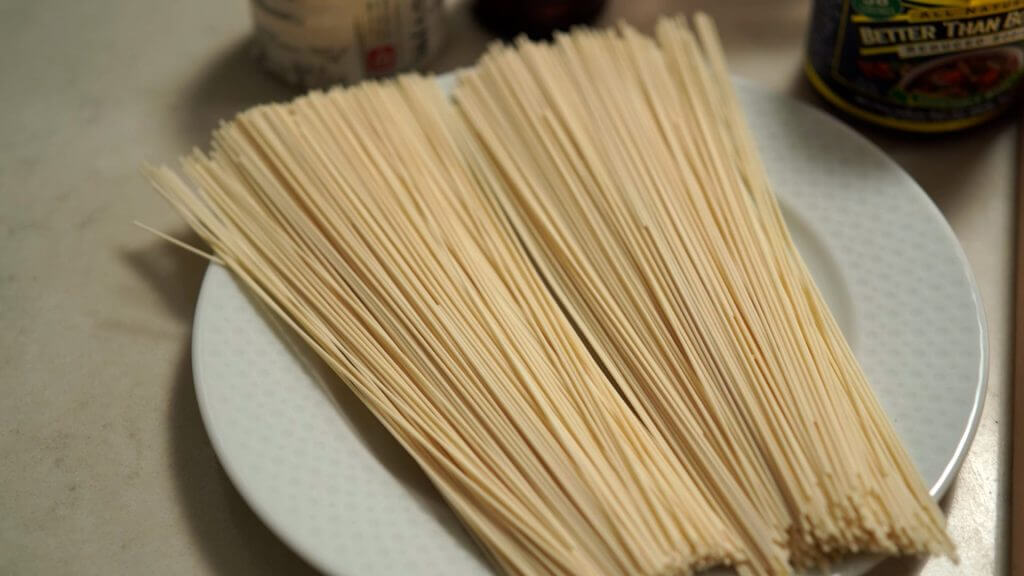
if you haven’t cooked with somen before, make sure that you’re using plenty of water when you’re cooking the noodles.
The last thing you want is your somen noodles to be stuck together or unevenly cooked.
Somen noodles on their own don’t have much of a strong flavor. So really, they are just the vehicle for all the deliciousness that the mushrooms are going to be carrying right into your mouth.

Key points after cooking the somen noodles
Once your Somen noodles are done cooking, you’re going to be draining them and then rinsing them with some cold water.
This helps expedite the cooling and stop the cooking.
Then you’re going to soak it in an ice water bath to drop the temperature until they are ready to be served.
I usually like to place a strainer into a water bath, so that I can actually just lift up the strainer when they’re ready to serve and then drain them.
Last, before serving – make sure that you drain them thoroughly and give them a good squeeze, if you haven’t done that before, to make sure that there isn’t a ton of water that’s still stuck to those noodles.
Because nobody likes a diluted women japanese noodle dish, and yes nobody means you!

What do Japanese mushrooms taste like?
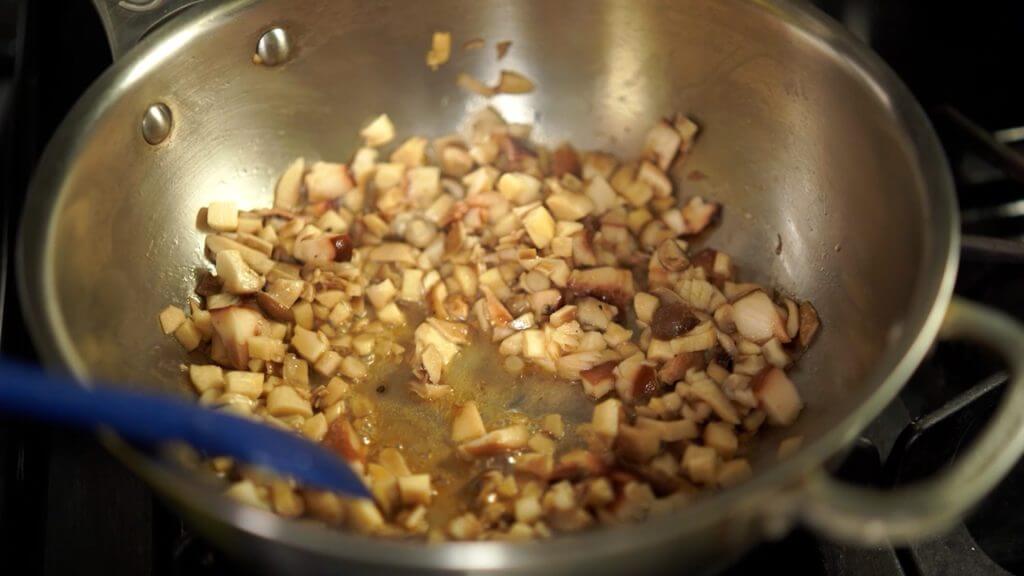
Japanese mushrooms and they can have a strong flavor if you’re new to them..
For someone who’s never had them before, they taste earthy, funky, woodsy, mushroomy in every sense.
A few things to help mitigate that for the newbies.
1. Make sure that you cut them into very small pieces. Cutting them smaller helps them cook quicker, release their funky umami packed juices as well as increase the surface area which is going to help to bring more non-mushroom flavor with each bite.
2. Use a variety of mushrooms to give you more of a complex flavor and dilute the flavor a bit.
They all do taste quite different from each other, at least I think so. (For this recipe, you won’t really be able to tell much though!)
3. Saute them for a good 20 to 30 minutes until they have caramelized, and turned much smaller in terms of the size and a little bit crispy on the outside and that’s going to help to give you a nice texture and new flavor that was never there before. Jyann! じゃん!
Just like magic.
Benefits of Japanese mushrooms in your cooking
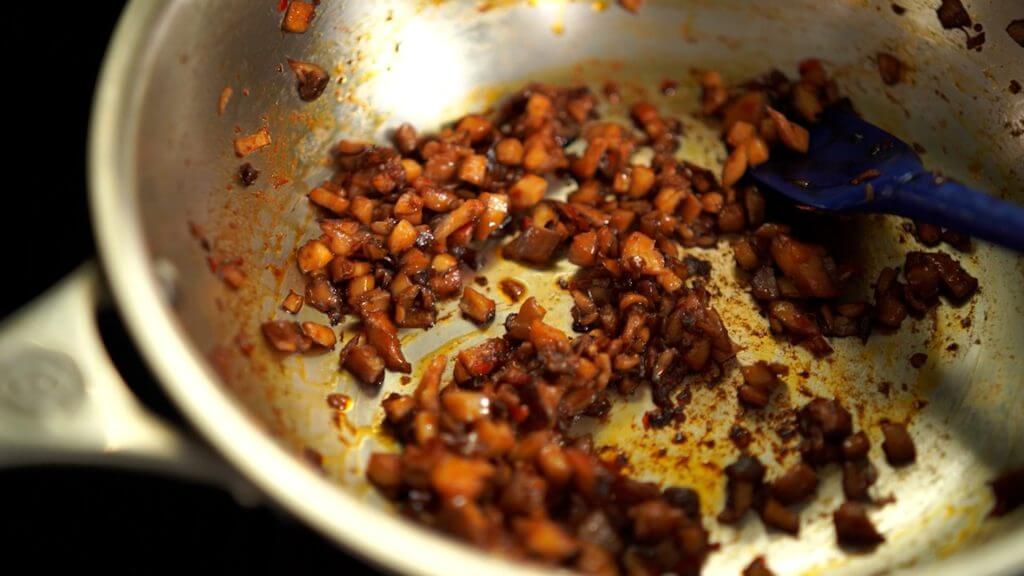
Are you wondering if youre going to ruin your mushrooms or lose the benefits?
1. Caramelized mushrooms in my opinion taste amazing. Just like caramalized onion or caramalized sugar, the food is completely transformed in the cooking process.
Not only does the flavor of your food improve thanks to the natural umami of the mushrooms, but you also get to enjoy some of the natural sweetness of the mushrooms when they caramelize.
2. As you may know, umami from different sources is not additive, rather it’s multiplicative in the effect.
The umami naturally present in mushrooms will synergize with all the other ingredients that we’re using and it helps to make for a much better overall flavor than each individual ingredient alone.
3. You like meat? Don’t like fake meat or non-meat foods? Well, poo!
The texture of mushrooms can change barely at all or quite a bit with extended cooking. If you haven’t tried the latter, perhaps nows a good time to try it out 🙂
The texture is almost like minced meat to me. A little firm, with a little cushion and just a bit of juice and chew when you bite down…just like your favorite minced meat, even though we’re not using any meats.
So to summarize this section, i hope i convinced you to make sure you cook the mushrooms longer than you think is necessary.
Toubanjian – chili paste
Regarding the toubanjian, the chili paste… It can have quite strong in flavor if you’ve never had it before, and it may or may not be strong in the spiciness department.
Usually Chinese brands might be a little bit more spicy than a Japanese brand, but of course, try different brands out and see what you prefer.
And if you like things a little bit on the spicier side, you can use a little bit more of the toubanjian or if you like things less spicy, then you might want to try a different recipe.
Kidding, I mean, not really actually. ha!
So even though this recipe may not be considered spicy, as compared to maybe spicy Thai food, spicy Indian foods, spicy Mexican food or other spicy cuisines, it can be a little bit spicy depending on how sensitive you are.
I’m only half kidding when I say try a different a recipe it’s totally up to you.
But in my opinion, it’s not that spicy, probably on between a one and a five, five being the most spicy.
I would say this is probably like a two, maybe a three… also may change depending on how much la-yu you’re throwing on there too
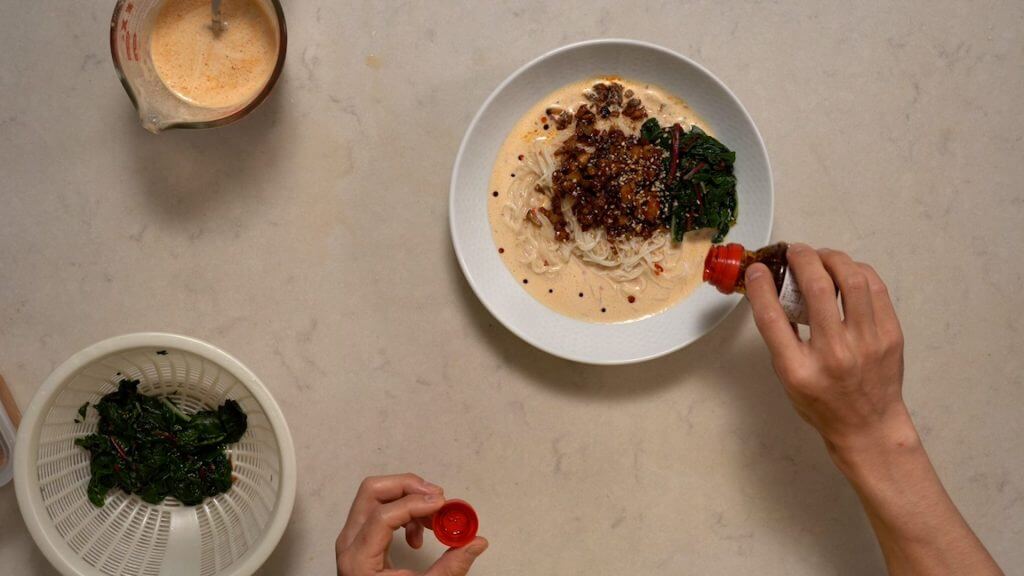
Tantanmen made simple with a few more tips
So in order to make this Tantanmen Somen your own, I think you have a few options for making some modifications without really altering the original flavor of the dish too much.
One is going to be to substitute the vegetable stock with your favorite other stock, maybe it’s a chicken or beef stock for example. I use the better than bullion brand. If you use the other flavors of that brand, I think you should be fine.
In addition, you can also use different types of miso paste.
Today I used a white miso that was made with Shiokouji.
You can also use a red miso, which is going to be a little bit darker in flavor or a different type of white miso which is going to be lighter and sweeter in flavor.
And depending on your preferences and your tastes. If you have something that’s a little bit darker or more savory, you might want to balance that out with a little bit of honey or sugar.
And on the other side, if you’re using a white miso that’s more sweeter like a Saikyo miso, which is a white miso. You could add in maybe like a bit of dashi or soy sauce, to make things a little bit more savory.
And if you really, really really don’t want to use Japanese mushrooms, you have a couple options.
1. use a whole grain or cracked grain like Bulgur or Farro,
2. crumbled bits of extra firm tofu
3. lentils.
those three are my favorite sources of plant protein and could be some good alternatives to give you sort of that minced meat texture if that’s whatcha want!
And in addition, if it is in the winter or the fall season, when things are a little bit cooler, temperature wise, and you want something a little bit more comforting or a little bit more warming, you can use this exact recipe and serve it over a warm brown rice.
So that’s another tasty alternative.
To serve it over warm brown rice with the soup or the broth on the side, sort of like a deconstructed or dry noodle dish.
Only this time it will be a dry rice dish if that makes sense.
I think it makes sense. It makes sense to me at least.
So dry noodles, dry rice.

Your next steps
So let me know what you think, if you enjoy this recipe, give my video a thumbs up to let me know. Share this with a friend, somebody that you think would be interested in cooking something like this.
If you have any feedback comments, make sure to share them below. If you haven’t subscribed to my channel, subscribe for more plant based Japanese cooking videos just like the one today.
One last thing if you are ever visiting Japan in the summertime, especially Kyoto, that area of Japan, there’s actually a really touristy thing that you can do to eat Somen and that is to eat it after it comes down a hollowed out piece of bamboo.
So it’s called Nagashi somen which means sort of like flowing somen, and literally there is flowing water that is coming down hollowed out bamboo pieces, and you can go ahead and pick it up with your ohashi or your chopsticks and eat it straight out of that bamboo piece.
So that’s something that you may be interested in trying on your next visit. A little bit touristy, but similar to Kaiten sushi, which is you know, the sushi that comes around on a conveyor belt, only this is Somen that is coming down a hollowed-out piece of bamboo with some water.
Touristy.
Yes, tasty?
You tell me.
PrintIngredients
For the mushrooms
- 1 ½ cups japanese mushrooms, finely chopped (shiitake, maitake, shimeji, eryngii)
- 1 Tbsp sesame oil
- 1 Tbsp toubanjian
- 2 Tbsps sake
- 2–3 tsps soy sauce
For the broth
- 1 ½ cups soy milk, unsweetened and unflavored
- 2 Tbsps nerigoma (white tahini)
- 2 tsps miso paste
- 2 tsps vegetable stock concentrate (better than bouillon)
- 2–3 tsps toubanjian
- 1–2 tsps honey or sugar
For the noodles
- Leaves of one bunch rainbow chard, steamed
- 1 bundle somen noodles per person
For topping
- La-yu (chili oil)
- White pepper
- Toasted and ground sesame seeds
- Chopped green onions











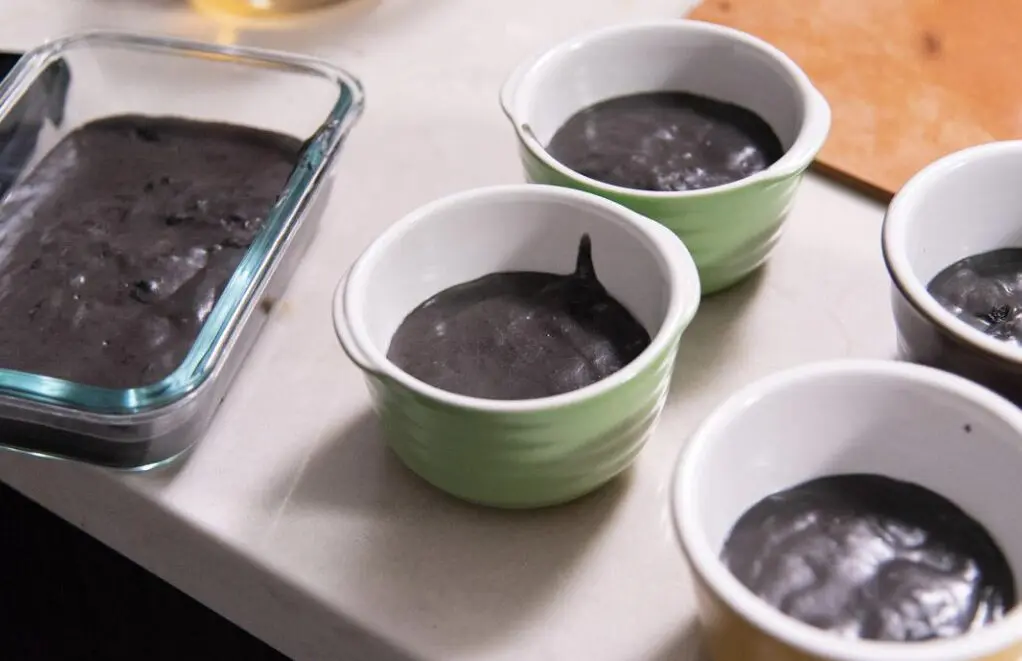

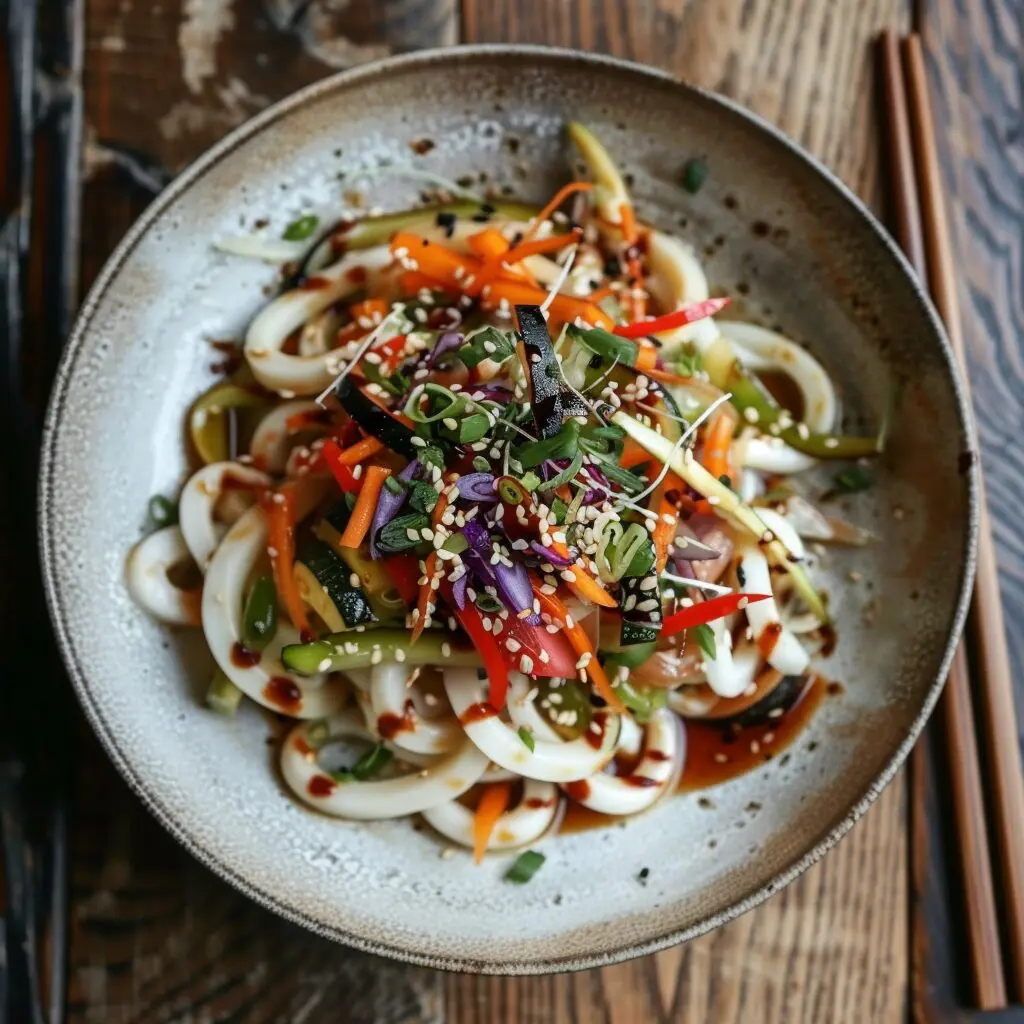

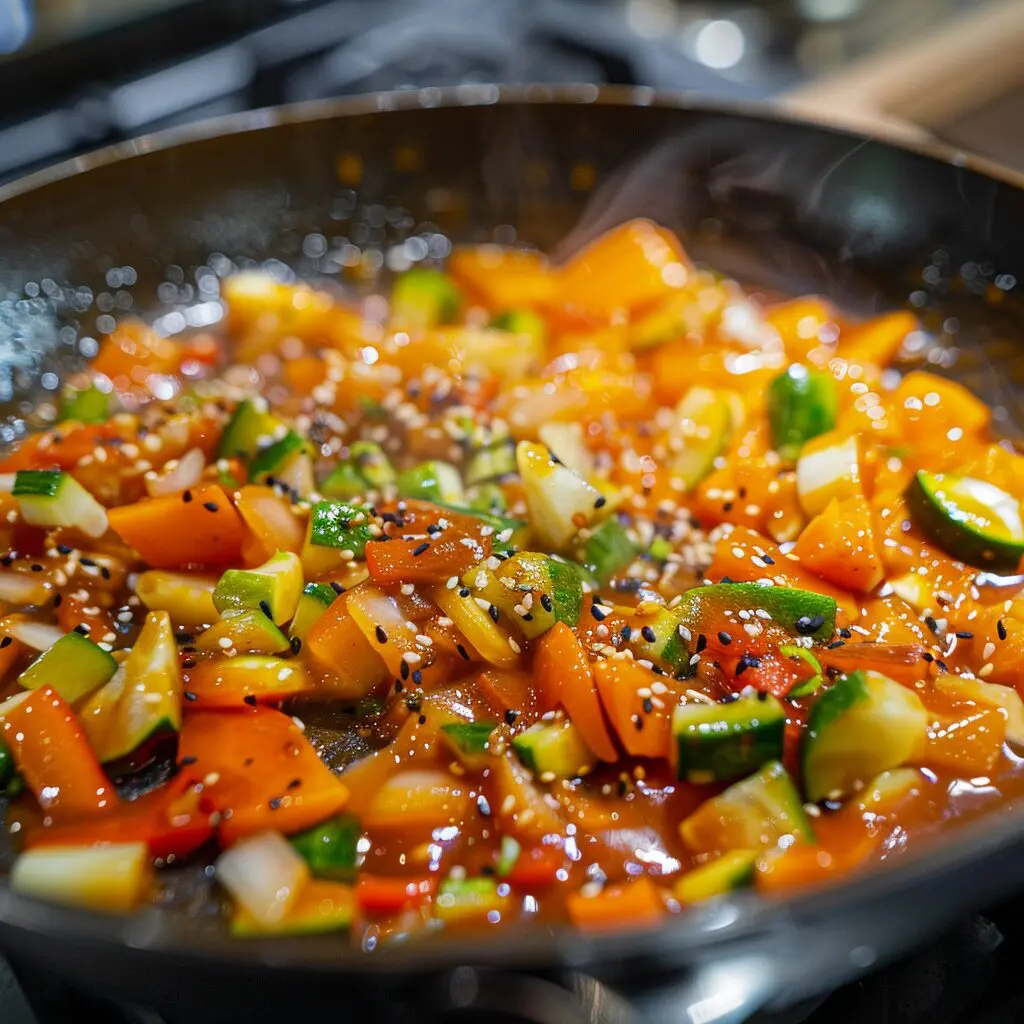

Konnichiwa! (Hello!) I'm Pat Tokuyama, a Japanese tofu cookbook author, who travels for music, food, and adventure. If you like Japanese tea, checkout some of the newestorganic japanese tea, matcha bowls and noren and more!
** Curious about the Plant Based Japanese Cooking Club? ** Learn more here!